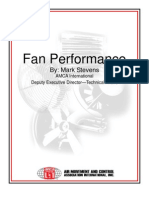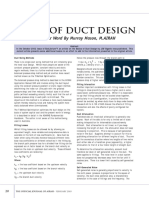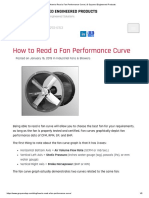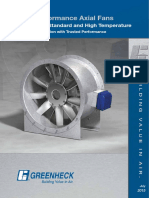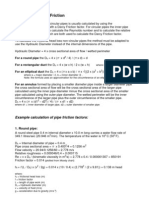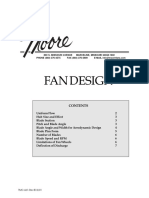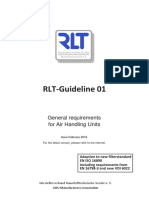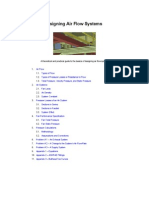0 ratings0% found this document useful (0 votes)
97 viewsFans in Air Handling Units - WTP 38 2
Fans in Air Handling Units - WTP 38 2
Uploaded by
jameeloCopyright:
© All Rights Reserved
Available Formats
Download as PDF, TXT or read online from Scribd
Fans in Air Handling Units - WTP 38 2
Fans in Air Handling Units - WTP 38 2
Uploaded by
jameelo0 ratings0% found this document useful (0 votes)
97 views23 pagesCopyright
© © All Rights Reserved
Available Formats
PDF, TXT or read online from Scribd
Share this document
Did you find this document useful?
Is this content inappropriate?
Copyright:
© All Rights Reserved
Available Formats
Download as PDF, TXT or read online from Scribd
Download as pdf or txt
0 ratings0% found this document useful (0 votes)
97 views23 pagesFans in Air Handling Units - WTP 38 2
Fans in Air Handling Units - WTP 38 2
Uploaded by
jameeloCopyright:
© All Rights Reserved
Available Formats
Download as PDF, TXT or read online from Scribd
Download as pdf or txt
You are on page 1of 23
1
Copyright Woods Air Movement Limited. England 2000
WOODS AIR MOVEMENT LIMITED
FANS IN
AIR HANDLING UNITS
by
S.D. Desmond C Eng., M.C.I.B.S.E.
Senior Applications Engineer
of
Woods of Colchester Limited
Tufnell Way
Colchester CO4 5AR
United Kingdom
March 1993
AI R M O V EM EN T
2
FANS IN AIR HANDLING UNITS
Introduction
People tend to be creatures of habit and to use equipment they have used before. Air handling unit
manufacturers will tend to offer units containing the type of fan requested by a customer. Therefore, fans in
air handling units are either of the type normally supplied by the manufacturer of the air handling unit or of a
type used previously by the customer.
The purpose of this paper is to enable Engineers who specify fans, to
compare the installation effect, space limitation and silencing requirement
of the three main types of fan when mounted in Air Handling Units.
The three main types of fan compared are:-
Centrifugal
Mixed Flow
Axial
General comparisons can be taken from this paper but the specific comparisons in section 6 are for specific
duties and compare Woods Axcent 2 mixed flow fans, Woods Varofoil axial flow fans, and backward curved
centrifugal manufactured by others.
For particular projects it would be advisable to approach the fan manufacturer direct.
Each of the different types has advantages and disadvantages depending on the installation. The overall
benefits should be considered before final fan selection.
3
Contents
1. Description Of The Three Main Fan Types :
Centrifugal, Mixed Flow and Axial
2. Test Methods:
BS848:1963, ducted fans
BS848:1980, type A, B, C & D connections
3. Fan Outlet Velocity Profile:
Why non-ducted outlets generate extra losses
4. Installation Effects:
a. Centrifugal fans
b. Mixed flow fans
c. Axial flow fans
5. Recommended Minimum Distances Upstream, Downstream And Sides, Below
Which Fan Performance Will Be Adversely Affected
6. Comparisons Of Fans In Air Handling Units Showing:
a. Absorbed power
b. Length of air handling units
c. Noise levels
7. Other Aspects:
a. Direct drive / Belt drive
b. Stall characteristics
c. Non-overloading characteristics
d. Variable duty
e. Dynamic pressure regain
f. Motor location on belt driven fans
g. Multi-staging
8. Sketches And Photographs Of Various Installations
4
Fig.2 Performance Characteristics Of
Centrifugal, Mixed Flow And Axial
Flow Fans Of A Specified Power
P
r
e
s
s
u
r
e
Volume Flow
Centrifugal
Mixed Flow
Axial
Fig.3 BS848:1963
For the same power a centrifugal fan will develop
higher pressures at lower volume flows than the axial
flow fan with the mixed flow fan coming in between.
Fig. 2 indicates the relative coverage in performance
of the three types of fan.
1) Description of the Three Main Fan
Types
There is a tendency to consider a fan in which the
outlet air flows at right angles to the inlet air as a
centrifugal fan, and a fan in which the outlet air flows
in the same direction as the inlet air as an axial flow
fan.
In fact, centrifugal fans impart motion to the air by
centrifugal force and axial flow fans by compressive
force.
An impeller using both centrifugal and compressive
force to move the air is a mixed flow fan.
Fig. 1 shows the flow pattern through the three types.
Fig.1 Flow Pattern Through Different
Types Of Fans
Centrifugal Axial
Mixed Flow
It should be noted that volume flow is the prime
requirement of a fan and that pressure is simply a
function of the system when the required volume flow
is passed through it.
For example, some Variable Air Volume systems
have terminal units which, for their operation, depend
on a duct pressure immediately upstream. When
these terminal units fail to operate there is a tendency
to argue that the fan is not producing enough pressure.
However, the pressure immediately upstream of the
terminal unit is a function of the volume flow through
the unit and the downstream ducting. Therefore, to
make the terminal unit work, it is necessary to increase
the volume flow through it and not the fan pressure.
2) Test Methods
Fans of all types, and origins, are tested to various
standards. In Germany, it is the DIN standard. In the
U.S.A., it is the A.M.C.A. standard.
In the U.K. the standard that all fans are tested to is
British Standard 848.
Fans designed prior to 1980 were tested to
BS848:1963. Fans designed after 1980 are tested to
BS848:1980.
Fig. 3 indicates, in simplified form, the 1963 test
method. Note that straight inlet and outlet ducting is
used. If a fan is installed without ducting there will be
an installation loss, or system effect factor, which will
reduce the useful fan performance.
2 x Dia. Long 4 x Dia. Long
Axial
Fan
Flow
4
x
D
i
a
.
L
o
n
g
Flow Centrifugal
Fan
2 x Dia. Long
5
Fig. 4 indicates, in simplified form, the 1980 test
method. Fans designed after 1980 and tested to this
standard have four different connection types: -
A, B, C and D.
When identical fans are tested to both the 1963
method and the 1980 method, different duties are
recorded. This is due to a different inlet cone calibration
and to a flow straightener downstream.
The 1980 type D Category indicates a reduced
performance, compared with the 1963 ducted method,
even though the fans are identical. For two particular
designs the differences are:-
Centrifugal Fans =
2% lower volume flow.
2 to 4% lower static pressure.
3 percentage points lower efficiency.
Axial Flow Fans =
4% lower volume flow.
5 to 10% lower static pressure.
4 percentage points lower efficiency.
For either test, the BS848 Class B tolerance, which
allows minus 5% volume flow, minus 3% efficiency,
and plus 10% input power, is the accepted tolerance
unless otherwise agreed in advance.
A majority of fans sold in this country were designed
and tested before 1980 and their performances are
therefore based on the 1963 method. Specifications
calling for fans tested to BS848:1980 could prevent a
majority of fans being offered unless additional tests
are conducted at considerable extra cost.
Symbol
V
V
V
V
= Fan
A
B
C
D
Type
Free Inlet - Free Outlet
Free Inlet - Ducted Outlet
Ducted Inlet - Free Outlet
Ducted Inlet - Ducted Outlet
Connection
Fig.4 BS848:1980
3) Fan Outlet Velocity Profile
When fans discharge into a plenum chamber without
any outlet duct, there is an uneven velocity profile
which reduces the effective fan performance.
Fig.5 shows the velocity profile of centrifugal and
axial flow fans when followed by ducting.
As can be seen, it can take a straight length of duct up
to 10 fan diameters long before this profile is equalised.
The severity of this loss depends on the degree of
distortion to the velocity profile and the residual swirl
at the fan outlet. It is often calculated as a percentage
of the nominal fan dynamic pressure, although the
situation is actually much more complex.
It should be noted that the side tapping of a pitot tube in
the downstream duct or plenum chamber will not indicate
the available static pressure because some of the high
velocity profile will be converted into static pressure.
Axial
Velocity
Distribution
G
ro
s
s Total Pressure
F
a
n
Total Pressure
F
a
n
S
tatic Pressure
Excess
Velocity
Pressure
Conventional
Velocity
Pressure
Fan
Static
Pressure
2 4 6
L
D
Fig.5 Fan Outlet Velocity Profile
6
4) Installation Effect
Fig.6 shows the installation effect on a backward
curved DIDW centrifugal fan in a plenum or AHU.
Four curves are shown indicating catalogue total
pressure, static pressure (ducted), static pressure
(un-ducted), and finally laboratory measured static
pressure each side of an air handling unit fan section.
The fan was mounted with the inlet at 0.25 diameters
from the side walls and with inlet guards. This indicates
how extensive the installation effect can be for a
typical installation.
Table A shows typical installation effects on fan
performances as a function of the nominal fan dynamic
pressure, Pdf.
It should be taken as a general guide for comparison
purposes only because different manufacturers advise
different installation effects.
Note that the last item is a regain cone and the effect
is to convert fan annular dynamic pressure into static
pressure possi bl y reduci ng motor power
requirements.
Attention should be paid to the effect of uneven air
flow over other items of plant located upstream or
downstream of the fan.
Fig. 7 shows the installation effect on an Axcent 2
mixed flow fan, based on laboratory tested
measurements.
TABLE A. TYPICAL FAN INLET AND OUTLET LOSSES
(Catalogue Performances Are Based On Ducted Inlet And Outlet)
CONNECTION CENTRIFUGAL AXCENT 2 VAROFOIL
No Inlet Duct
1 Pdf
(Spigotted)
0.5 Pdf
(Flanged)
0
(Integral
Bellmouth)
0.9 Pdf
Added Bellmouth 0 0
0.06 Pdf
(Negligible)
Bellmouth Guard & Bellmouth
0.03 Pdf
(Negligible)
0.3 Pdf 0.16Pdf
No Outlet Duct
0.5 to 3 Pdf
(Depends on throat
to outlet ratio)
0.5 Pdf
0.3 to 0.8 Pdf
(Depends On Hub
Dia.)
Outlet Guard 0.1 Pdf 0.5 Pdf 0.1 to 0.3 Pdf
Open Outlet Damper 1 Pdf 0.5 to 1 Pdf 0.5 Pdf
Outlet Cone
Up to 0.75 Pdf
(Regain)
Up to 1 Pdf
(Regain)
Up to 0.5 Pdf
(Regain)
1300
1200
1100
1000
900
800
700
600
500
400
300
200
0.0 0.5 1.0 1.5 2.0 2.5 3.0 3.5
Axcent 2 BS848 Part 1: 1980 Type A Test Rig
Axcent 2 In Air Handling Unit Test Rig
Volume Flow (m
3
/s)
S
t
a
t
i
c
P
r
e
s
s
u
r
e
(
P
a
)
10
0
20
30
40
50
O
v
e
r
a
l
l
E
f
f
i
c
i
e
n
c
y
%
Fig.7 Axcent 2 Comparison
Of Measured Performances
16%
Short
Fall On
System Line
4
7
%
R
e
d
u
c
t
i
o
n
I
n
A
v
a
i
l
a
b
l
e
E
x
t
e
r
n
a
l
P
r
e
s
s
u
r
e
A
t
G
i
v
e
n
F
l
o
w
r
a
t
e
2500
2000
1500
1000
500
F
a
n
P
r
e
s
s
u
r
e
s
P
S
F
a
n
d
P
T
F
(
P
a
)
0 2 4 6 8 10 12 14
q
v
Volume Flow (m
3
/s)
Fan Total Pressure P
TF
From
Catalogue
Fan Static Pressure P
SF
Calculated
From
Catalogue (P
TF
- P
D
)
Fan Static Pressure P
SF
Unducted
(Catalogue Minus 2P
D
)
Measured P
SF
Of Fan In Box (AHU)
PF
qv
2
Fig.6 RZR 560 mm DIDW
Centrifugal Fan @ 2050 rev/min
Handling Air 1.2 kg/m
3
Duty 8.0 m
3
/sec @ 1.5 kPa
7
Fig. 8 shows further variations in performance of an
Axcent 2 mixed flow fan mounted in an air handling
unit section. Note that there is little variation in fan
performance due to the proximity of plant items
upstream and downstream. There is a reduction in
performance, though fairly small, if the discharge
from the downstream section is at right angles and
not in a straight line.
5) Recommended Minimum Distances
Upstream, Downstream and at the Sides
below which Fan Performance will be
Adversely Affected.
Fig. 9 shows a sketch of fan position in an air handling
unit. The table indicates minimum recommended
distances, for various types of fan, below which the
installation effect factors previously discussed would
no longer apply. Before using these distances the fan
manufacturer should be consulted as these
recommendations vary between manufacturers.
1500
1400
1300
1200
1100
1000
900
800
700
600
500
400
300
200
0.0 0.5 1.0 1.5 2.0 2.5 3.0
Volume Flow (m
3
/s)
S
t
a
t
i
c
P
r
e
s
s
u
r
e
(
P
a
)
330 mm
Or
170 mm
Fan Installed Without Downstream Splitters
Downstream Splitters At 270 mm From Fan Outlet
Upstream Coil At 125 mm From Fan Inlet
Side Discharge With Side Wall At 330 mm From Fan Inlet
Side Discharge With Side Wall At 170 mm From Fan Inlet
- Little Change
- Little Change
- Little Change
- As Sketch
- As Sketch
Fig.8 Effect On Performances
Due To System Components
B A
C
Fan
Flow
Fig.9 Recommended Minimum
Distances Upstream, Downstream
And Sides Below Which Fan
Performance Will Be
Adversly Effected
Dim.
A
B
C
Minimum
Normal
Critical
Minimum
Normal
Critical
Minimum
Varofoil
D
D
1D
1D
1 D
1 D
D
1
2
1
4
1
2
3
4
1
2
Axcent 2
D
D
1 D
D
1D
1D
100 mm
1
2
1
4
1
2
(* If D Max. Then Add VH To The Required Pressure)
D = Fan Inlet Diameter
Minimum:
Is Minimum Distance Below Which Fan Performance Will Be
Reduced. Allowance Must Be Made For Turbulence Through
Other Components.
Normal:
Is As Minimum But No Allowance Is Required On Other Components.
Critical:
Is If Unit Width Or Height To Fan Diam Exceeds 3 To 1.
1
2
1
2
*
Cent.
D
D
D
1D
1 D
1 D
D
1
2
1
4
1
2
1
2
1
2
2
3
8
6) Comparisons of Centrifugal, Mixed
Flow and Axial Flow Fans in Air Handling
Units.
Five typical duties have been selected for specific
comparison. As specific duties have been used, it is
necessary to compare specific fans and not fans in
general. Therefore all the fans compared are as
would be offered commercially. The RZR backward
curved centrifugal fan, the Woods Axcent 2 mixed
flow fan, and the Woods Varofoil axial flow fan, are
the fans being considered.
Three aspects are compared:-
(a) Absorbed Power: including belt losses where
necessary but not inverter losses where inverters are
required. Higher efficiency centrifugal fans could
have been selected but would be larger, further
increasing AHU size.
(b) Air Handling Unit Length: including minimum
recommended lengths of upstream and downstream
plenums.
(c) Sound Power Levels (Ref: 1 pW): in each octave
band, at the fan outlet. Overall sound power levels
are shown in brackets.
A full system acoustic analysis for a typical installation,
for each of the fans for example 6.3 follows the
comparisons. This shows that even more unit length
can be saved because of the shorter silencers required
in units with mixed flow or axial fans.
Example 6.1: DUTY 3 m
3
/s at 500 Pa SP.
FAN ABS.POWER AHU LENGTH
CENTRIFUGAL 5.1 kW 1705 mm
AXCENT 2 3.1 kW 1485 mm
VAROFOIL 4.2 kW 2260 mm
SOUND POWER LEVEL
Hz 63 125 250 500 1k 2k 4k 8k
CENTRIFUGAL 100 94 95 89 85 83 78 74 (102)
AXCENT 2 77 90 92 93 88 81 79 73 ( 98)
VAROFOIL 85 87 98 97 96 93 88 82 (102)
Example 6.2: DUTY 7 m
3
/s at 700 Pa SP
FAN ABS.POWER AHU LENGTH
CENTRIFUGAL 16.1 kW 2230 mm
AXCENT 2 12.3 kW 1760 mm
VAROFOIL 14.2 kW 2260 mm
SOUND POWER LEVEL
Hz 63 125 250 500 1k 2k 4k 8k
CENTRIFUGAL 106 100 101 95 91 89 84 80 (109)
AXCENT 2 85 96 101 103 97 90 88 84 (107)
VAROFOIL 89 91 102 101 100 97 92 86 (106)
Example 6.3: DUTY 12 m
3
/s at 1000 Pa SP
FAN ABS.POWER AHU LENGTH
CENTRIFUGAL 26.2 kW 2630 mm
AXCENT 2 22.5 kW 2322 mm
VAROFOIL 20.0 kW 2562 mm
SOUND POWER LEVEL
HZ 63 125 250 500 1k 2k 4k 8k
CENTRIFUGAL 109 104 104 97 92 87 87 83 (111)
AXCENT 2 92 100 104 104 99 94 90 89 (109)
VAROFOIL 97 98 107 106 105 102 97 91 (111)
9
Example 6.4: DUTY 15 m
3
/s at 1500 Pa SP.
FAN ABS.POWER AHU LENGTH
CENTRIFUGAL 33 kW 3500 mm
AXCENT 2 36 kW 2450 mm
VAROFOIL 41 kW 2825 mm
SOUND POWER LEVEL
Hz 63 125 250 500 1k 2k 4k 8k
CENTRIFUGAL 108 103 103 97 94 91 87 82 (111)
AXCENT 2 93 102 106 105 100 95 92 91 (111)
VAROFOIL 99 99 102 110 108 106 102 96 (114)
Example 6.5: DUTY 20 m
3
/s at 1500 Pa SP
A single centrifugal fan and a single Varofoil fan are used for comparison but, due to the relatively high duty,
two Axcent 2 fans and two smaller Varofoil fans, mounted in parallel, are also compared. With two fans in
parallel the comparisons take into account both fans and not a single fan.
FAN ABS.POWER AHU LENGTH
CENTRIFUGAL 47 kW 4300 mm
AXCENT 2 (2 FANS) 47 kW 2240 mm
VAROFOIL (1 FAN ) 48 kW 3420 mm
VAROFOIL (2 FANS) 50 kW 2409 mm
SOUND POWER LEVEL
Hz 63 125 250 500 1k 2k 4k 8k
CENTRIFUGAL 110 104 105 99 96 93 89 83 (112)
AXCENT 2 (2) 94 102 106 106 101 96 92 91 (111)
VAROFOIL (1) 98 101 108 109 107 104 99 95 (113)
VAROFOIL (2) 98 98 102 110 108 106 102 96 (114)
10
Full System Acoustic Analysis For Example 6.3
To attain NC35 on this system with a centrifugal fan requires a silencer 2100 mm long.
11
To attain NC35 on this system with a mixed flow fan requires a silencer 1050 mm long.
12
To attain NC35 on this system with a Varofoil requires a silencer 1350mm long.
13
Noise Levels
Fig. 10 shows a general comparison of sound pressure
levels, measured in a free field, at 1.5 m distance from
the fans. Fans were selected for the same duty.
Although both the Axcent 2 mixed flow fan and the
Aerofoil axial flow fan show higher noise levels above
250 Hz, both types have lower noise levels below
250 Hz when compared with the centrifugal fan.
The higher frequencies are more detectable to the
human ear and therefore appear subjectively noisier
but they are easier to attenuate.
On most systems requiring air handling units,
attenuation is necessary.
Invariably the size of the attenuator is dictated by the
lower frequencies, ie 125 Hz. The reason for this is
that attenuators have poor noise absorption at low
frequencies but good noise absorption at high
frequencies. This means that shorter attenuators,
compared to those used on centrifugal fans, can
frequently be used on mixed flow and axial flow fans.
as with centrifugal and mixed flow impellers, then
there is a distinct advantage with using a belt and
pulley drive because fan duties can be changed,
within the power limits of the motor, by changing
pulley ratios.
With belt driven fans motors are external to the fan
and are not connected directly to the impeller. The
motor can therefore be easily replaced.
Axial flow fan impellers can be easily adjusted for
different duties, within the motor power, but the
impeller must be removed if the motor needs replacing.
Belt drive fans have additional power losses, due to
the belts, over direct drive (average 5%).
Belts can be mis-aligned, and can wear, making them
slip or break.
Switched reluctance or eddy current speed controlled
motors can only be used with belt drive because of
their physical size.
Additional floor space may be required for the base
frame of a belt driven fan.
The motor on a belt driven fan could be mounted
outside the air stream.
(b) Stall Characteristics:
Generally, axial flow fans containing aerofoil section
blades set above specific blade angles, have a stall
characteristic where performance becomes unstable.
Selection should be avoided within 5% of the stall
point pressure.
Generally, mixed flow fans do not have stall
characteristics and are stable throughout their
performance curve down to zero flow.
Fig. 11 shows typical mixed flow performance curves.
Backward curved centrifugal fans often suffer from
rotating stall at low flows. This should be shown as a
discontinuity in the pressure/flow curve, although not
all catalogues admit to it's presence. It is, however,
rarely a problem except at low speeds on a speed
controlled fan, or at high turn down ratios when the
fan is fitted with radial vane inlet control.
(c) Non-overloading Characteristics:
Unlike forward curved centrifugal fans, all backward
curved centrifugal, mixed flow and axial flow fans
have non-overloading characteristics. This means
that the motors will not burn out if the system
characteristics are changed providing there is no
contra-swirl in the air approaching the fan.
7) Other Aspects
(a) Direct Drive / Belt Drive:
Most types of fan can be either direct drive or belt
drive. Medium to large centrifugal fans are normally
belt driven. Mixed flow fans can be direct drive but are
normally belt driven . Axial flow fans can be belt driven
but are normally direct drive.
Advantages/Disadvantages:
If the impeller of a fan gives only a fixed performance,
Octave Band Mid-Frequency (Hz)
S
o
u
n
d
P
r
e
s
s
u
r
e
L
e
v
e
l
(
d
B
)
-
A
t
1
.
5
m
F
r
e
e
F
i
e
l
d
80
75
70
65
85
60
55
50
63 125 250 500 1000 2000 4000 8000
Axcent 2
Aerofoil
Centrifugal Competitor A
Centrifugal Competitor B
Fig.10 Comparison Of Sound Levels
14
3000
2000
1000
500
250
0 1 2 3 4 5 6
75 85 95
100
98
96
94
92
90
88
P
S
F
-
F
a
n
S
t
a
t
i
c
P
r
e
s
s
u
r
e
(
P
a
)
q
v
- Volume Flow (m
3
/s)
%
M
a
x
.
P
o
w
e
r
BS848:1980
V
(e) Dynamic (velocity) Pressure Regain:
As shown earlier, mixed flow and axial flow fans can
be provided with regain cones to convert some of the
fan dynamic pressure to useful static pressure. Also,
by reducing the fan outlet velocity a better air
distribution may be obtained on downstream items of
equipment.
(f) Motor Location on Belt Drive Fans:
Generally, motors and drives on centrifugal fans take
up floor space on a base frame. Heavier motors on
mixed or axial flow fans would also be belt driven and
be mounted the same way but smaller motors with
belt drives can be mounted on top of the fan casing
saving floor space.
(g) Multi-staging:
Centrifugal fans can be mounted in parallel to increase
volume flows.
Mixed flow and axial flow fans can be mounted both
in parallel and in series to increase both volume flow
and pressure.
Consideration should be given to using two, or more,
mixed flow or axial flow fans, in parallel, in place of
one large fan. The advantages are that a better
aspect ratio of the air handling unit may be possible,
mounting one fan above the other will increase usable
floor area, and up to 65% volume flow stand-by could
be available if one of the two fans fail. In addition, on
a variable air volume system, it would be possible to
run one fan only during the winter, when lower flows
are required, to give increased power saving.
Backdraught dampers should be used if one fan is to
be switched off.
Fig.11 Typical Mixed Flow
Performance Curves
With a forward curved centrifugal fan maximum power
occurs at maximum volume flow and zero static
pressure. Motors are typically selected for operation
some way up the performance curve, where the
power required is lower than at maximum volume
flow. Therefore, opening dampers in the system
could overload the motor.
Some axial flow fans with anti-stall devices draw
excessive power at the low volume flow/high pressure
part of their characteristic. Motors may not be selected
for this condition and closing dampers in the system
could overload the motor.
(d) Variable Duty:
All fan duties can be varied using the relatively out-of-
date variable inlet guide vane units.
Both centrifugal and mixed flow fan performances
can be varied using frequency converters (inverters),
switched reluctance drives or eddy current couplings,
ie. speed control devices.
Axial flow fans can also be speed controlled. As an
alternative, they can be built with a mechanism to
vary their blade angle whilst in motion, ie. variable
pitch in motion. One advantage of this is that the fan
can develop maximum pressures at low volume flow
which is useful for systems with variable duty requiring
a high fixed pressure at low volume flows.
15
8) Sketches and Photographs of Specific Installations:
Installation of 1 m diameter Mixed Flow fan.
Dimensions in Millimetres
H
E
I
G
H
T
2
5
0
0
MX100B
AXCENT 2.
7.5-9.0 m
3
/s
LENGTH 3600
SIDE VIEW
W
I
D
T
H
3
3
0
0
-
+
PLAN
16
CONTROL PANEL
C
C
1
2
2
5
0
0
SHELL & TUBE
CONDENSERS
C
MX80
FAN
+
-
H
R
D
X
2000
2
6
0
0
+
SIDE VIEW
PLAN
Dimensions in Millimetres
Mixed Flow fan with air discharging vertically.
1
7
A 2
1
0
0
2400
OVERALL 7250
NR80
600
1800 400
OVERALL 6500
+
+
-
NR75
(NR55 IN
EQUIVALENT
LENGTH)
Dimensions in Millimetres
C
o
m
p
a
r
i
s
o
n
o
f
M
i
x
e
d
F
l
o
w
w
i
t
h
C
e
n
t
r
i
f
u
g
a
l
f
a
n
.
(
1
)
1
8
OVERALL 5200
OVERALL 5800
AXCENT 2 - Also available side discharge
Dimensions in Millimetres
C
o
m
p
a
r
i
s
o
n
o
f
M
i
x
e
d
F
l
o
w
w
i
t
h
C
e
n
t
r
i
f
u
g
a
l
f
a
n
.
(
2
)
1
9
80KG
D
80KG
D
508
1
3
4
1060
200
762
TOTAL LENGTH APPROX. 2840 WITH GASKETS
125KG
1016
2
1
0
1390
1
6
2
1016
TOTAL LENGTH APPROX. 3815 WITH GASKETS
1
5
8
Dimensions in millimeters
C
o
m
p
a
r
i
s
o
n
o
f
t
w
o
V
a
r
o
f
o
i
l
f
a
n
s
w
i
t
h
a
s
i
n
g
l
e
,
l
a
r
g
e
r
V
a
r
o
f
o
i
l
.
2
0
AXCENT 2
2
5
0
0
a
p
p
r
o
x
.
910
MX80
MX80
Min Width AHU - 1000
A68 DIDW
1080 510 510
Min. Width AHU - 2100
Dimensions in Millimetres
DIDW Centrifugal
T
w
o
M
i
x
e
d
F
l
o
w
f
a
n
s
i
n
p
a
r
a
l
l
e
l
(
m
o
u
n
t
e
d
o
n
e
a
b
o
v
e
t
h
e
o
t
h
e
r
)
i
n
c
o
m
p
a
r
i
s
o
n
w
i
t
h
a
D
I
D
W
C
e
n
t
r
i
f
u
g
a
l
f
a
n
.
21
Two Axcent 2 Mixed Flow fans in parallel
Further Reading:
WOODS PRACTICAL GUIDE TO
FAN ENGINEERING.
Marketing Department
Woods Air Movement Limited
Tufnell Way
Colchester
Essex
CO4 5AR
Telephone:- 01206 244377
HEVAC GUIDE TO GOOD PRACTICE
AIR HANDLING UNITS.
HEVAC Association
The Federation of Environmental
Trade Associations
Sterling House
6 Furlong Rd
Bourne End
Buckinghamshire
SL8 5DG
Telephone:- 06285 31186/7
WOODS PRACTICAL GUIDE TO
NOISE CONTROL.
Marketing Department
Woods Air Movement Limited
Tufnell Way
Colchester
Essex
CO4 5AR
Telephone:- 01206 244377
Ref: WTP38
Whilst all appropriate care has been taken in the preparation of this document,
neither Woods Air Movement Ltd. or the author give any warranty in respect of the contents.
You might also like
- Centrifugal FansDocument19 pagesCentrifugal FansMark John Santos71% (7)
- AMCA Fan Performance PDFDocument16 pagesAMCA Fan Performance PDFthevellin154No ratings yet
- Noise Reduction in Centrifugal Fans: A Literature SurveyDocument29 pagesNoise Reduction in Centrifugal Fans: A Literature SurveyPooria1989No ratings yet
- (ER5-3) Tee, 45 Degree Entry Branch (Ab/As Ab/Ac 0.5 As Ac), Converging (SMACNA 1990, Sepsy 1973)Document1 page(ER5-3) Tee, 45 Degree Entry Branch (Ab/As Ab/Ac 0.5 As Ac), Converging (SMACNA 1990, Sepsy 1973)Krishna PATELNo ratings yet
- Minimizing Fan Energy CostsDocument9 pagesMinimizing Fan Energy Costsmemep1No ratings yet
- Effect of Tip Clearance On Performace of Axial Flow FanDocument9 pagesEffect of Tip Clearance On Performace of Axial Flow Fancalcy4meNo ratings yet
- Aero Vent - Fan EngineeringDocument4 pagesAero Vent - Fan EngineeringMeera IyerNo ratings yet
- Air Flow in Ducts: Now That You Can Size Equipment, The Next Task Would Be To Design The Air Distribution SystemDocument22 pagesAir Flow in Ducts: Now That You Can Size Equipment, The Next Task Would Be To Design The Air Distribution SystemMukti WibowoNo ratings yet
- Basics of Duct DesignDocument2 pagesBasics of Duct DesignApurv Goyal100% (1)
- Part 1 - Air in MotionDocument5 pagesPart 1 - Air in Motionrahuldubey1987100% (1)
- Fan Curves 2 PDFDocument5 pagesFan Curves 2 PDFdasmechNo ratings yet
- Uaet Industrial Noise Series Viii Absorptive Silencer DesignDocument9 pagesUaet Industrial Noise Series Viii Absorptive Silencer DesignSérgio AmorimNo ratings yet
- High Performance Axial Fans: Model RA - Standard and High TemperatureDocument8 pagesHigh Performance Axial Fans: Model RA - Standard and High Temperaturerijothomasv777No ratings yet
- Orifice, Nozzle and Venturi Flow Rate Meters: Water & Air FlowmetersDocument4 pagesOrifice, Nozzle and Venturi Flow Rate Meters: Water & Air Flowmeterssiva_nagesh_2No ratings yet
- Part 8 Exhaust FanDocument7 pagesPart 8 Exhaust FanSteve WanNo ratings yet
- Fan PDFDocument28 pagesFan PDFpequenita34No ratings yet
- 4.6 Fans and BlowersDocument6 pages4.6 Fans and Blowerssrimant1984No ratings yet
- Heating, Venting, Air Conditioning, and Dehumidifying Systems - MIL-HDBK-1003-3Document227 pagesHeating, Venting, Air Conditioning, and Dehumidifying Systems - MIL-HDBK-1003-3hascribdNo ratings yet
- Fan Sound Sound Ratings Fe 300Document8 pagesFan Sound Sound Ratings Fe 300hardik033100% (1)
- Non Circular Pipe FrictionDocument3 pagesNon Circular Pipe Frictionravi_radanNo ratings yet
- Moore Fan 02Document7 pagesMoore Fan 02vikramNo ratings yet
- ME 415 Energy Systems Design TutorialDocument54 pagesME 415 Energy Systems Design TutorialcmahendrNo ratings yet
- Chap3 Fan NoiseDocument5 pagesChap3 Fan Noiseshehbazi2001No ratings yet
- Duct SystemDocument62 pagesDuct SystemPushp DuttNo ratings yet
- STC (Buffer Tank 25KL) - Calc PDFDocument4 pagesSTC (Buffer Tank 25KL) - Calc PDFAvril Rindra T PNo ratings yet
- Performance Characteristics of Axial FansDocument4 pagesPerformance Characteristics of Axial Fanskutts76No ratings yet
- Ac Sizing - Duct SizingDocument9 pagesAc Sizing - Duct SizingHarpreet SinghNo ratings yet
- Calculation For Background Noise AnalysisDocument10 pagesCalculation For Background Noise Analysisedm 60yNo ratings yet
- DesignAirSystems (Part 2)Document3 pagesDesignAirSystems (Part 2)marcoo8No ratings yet
- Assessment of Venturi Nozzle For Filter Bag Cleaning in PDFDocument0 pagesAssessment of Venturi Nozzle For Filter Bag Cleaning in PDFUmanath R PoojaryNo ratings yet
- Principles of Louver DesignDocument3 pagesPrinciples of Louver Designsaravanaplus100% (2)
- Hibon PD BlowerDocument3 pagesHibon PD BlowerAbhinav SaiNo ratings yet
- A C Engines and Jet Propulsion3Document152 pagesA C Engines and Jet Propulsion3Mukesh Kumar100% (1)
- Smoke Fans CatalogueDocument54 pagesSmoke Fans CataloguejayanthahhyNo ratings yet
- 13 PPT Fan SelectionDocument30 pages13 PPT Fan SelectionAli Zaib100% (1)
- Axial Centrifugal FansDocument15 pagesAxial Centrifugal FansAhsan JavedNo ratings yet
- The Fundamentals of Acoustic Design For Ventilation-Air Conditioning InstallationsDocument23 pagesThe Fundamentals of Acoustic Design For Ventilation-Air Conditioning Installationsblindjaxx100% (2)
- Smoke Tunnel ReportDocument11 pagesSmoke Tunnel ReportRana HanzlaNo ratings yet
- 893 Low Noise Solutions For Turbine Bypass To Air Cooled CondensersDocument10 pages893 Low Noise Solutions For Turbine Bypass To Air Cooled CondensersfelramNo ratings yet
- RLT-Guideline 01: General Requirements For Air Handling UnitsDocument25 pagesRLT-Guideline 01: General Requirements For Air Handling UnitsJorge RoblesNo ratings yet
- Howden 20american 20fan 20product 20catalogDocument8 pagesHowden 20american 20fan 20product 20catalogFarid ZubaidyNo ratings yet
- Knife Gate Valve Selection Guide 10.00 15Document6 pagesKnife Gate Valve Selection Guide 10.00 15dsyashankaNo ratings yet
- Part 12. Water and DX System - Chapter 1. Fan-Coil Unit SystemDocument1 pagePart 12. Water and DX System - Chapter 1. Fan-Coil Unit SystemKarthikeyan SankarrajanNo ratings yet
- Chapter-6 Fans and BlowersDocument62 pagesChapter-6 Fans and Blowersye htutkyawme100% (1)
- BOQ - King Salman Park 11 - FM200Document1 pageBOQ - King Salman Park 11 - FM200aNo ratings yet
- Models - Aco.absorptive MufflerDocument22 pagesModels - Aco.absorptive MufflerPeterNo ratings yet
- A Theoretical and Practical Guide To The Basics of Designing Air Flow SystemsDocument3 pagesA Theoretical and Practical Guide To The Basics of Designing Air Flow Systemsmarcoo8No ratings yet
- Ngineering ATA: Fan Sound & Sound RatingsDocument8 pagesNgineering ATA: Fan Sound & Sound RatingsRavi DeshmukhNo ratings yet
- Free Piping Design PDFDocument2 pagesFree Piping Design PDFChrisNo ratings yet
- Formulas in Cooling TowerDocument6 pagesFormulas in Cooling TowerGringoNo ratings yet
- Theory and Design of Centrifugal Fans: MINE 407 Mine Ventilation Lec16Document18 pagesTheory and Design of Centrifugal Fans: MINE 407 Mine Ventilation Lec16jbharghavNo ratings yet
- Air Flow MeasurementDocument2 pagesAir Flow MeasurementF.j. SabariagaNo ratings yet
- Equation-Loss Calc Large DuctsDocument2 pagesEquation-Loss Calc Large Ductskumar123rajuNo ratings yet
- ASHRAE Psychrometric ChartDocument1 pageASHRAE Psychrometric ChartKenneth Dale San JuanNo ratings yet
- Hap Free CoolingDocument2 pagesHap Free CoolingHnin PwintNo ratings yet
- Fan Application GuidelineDocument6 pagesFan Application GuidelineEdward SabedraNo ratings yet
- HVAC Handbook New Edition Part 6 Air Handling EquipmentDocument75 pagesHVAC Handbook New Edition Part 6 Air Handling EquipmentAbdul Nabi100% (9)
- HVAC Handbook Part 6 Air Handling EquipmentDocument75 pagesHVAC Handbook Part 6 Air Handling EquipmentTanveerNo ratings yet
- Axial Flow Fans General Information: Elta Impeller RangeDocument8 pagesAxial Flow Fans General Information: Elta Impeller Rangehardik033No ratings yet
- 221Document1 page221jameeloNo ratings yet
- Elevator Escalator MechanicsDocument1 pageElevator Escalator MechanicsjameeloNo ratings yet
- Simulink א א: א א א: Integrator& Diffrentiator) (Document4 pagesSimulink א א: א א א: Integrator& Diffrentiator) (jameeloNo ratings yet
- Ministry of Oil B.O.T.I / Baghdad: RotametrDocument1 pageMinistry of Oil B.O.T.I / Baghdad: RotametrjameeloNo ratings yet
- An Overview of Urban Transport in Sana'a (Yemen) : Et Al., 2012a) - It Serves Non-Drivers Poorly, DistributesDocument4 pagesAn Overview of Urban Transport in Sana'a (Yemen) : Et Al., 2012a) - It Serves Non-Drivers Poorly, DistributesjameeloNo ratings yet
- Subject: Power Plant Weekly Hours: Theoretical:2 : : 2 Tutorial: 1 : 1 Experimental: 1 : 1 Units: 5 : 5Document17 pagesSubject: Power Plant Weekly Hours: Theoretical:2 : : 2 Tutorial: 1 : 1 Experimental: 1 : 1 Units: 5 : 5jameeloNo ratings yet
- Lec1 - Introduction To OR PDFDocument9 pagesLec1 - Introduction To OR PDFjameeloNo ratings yet

